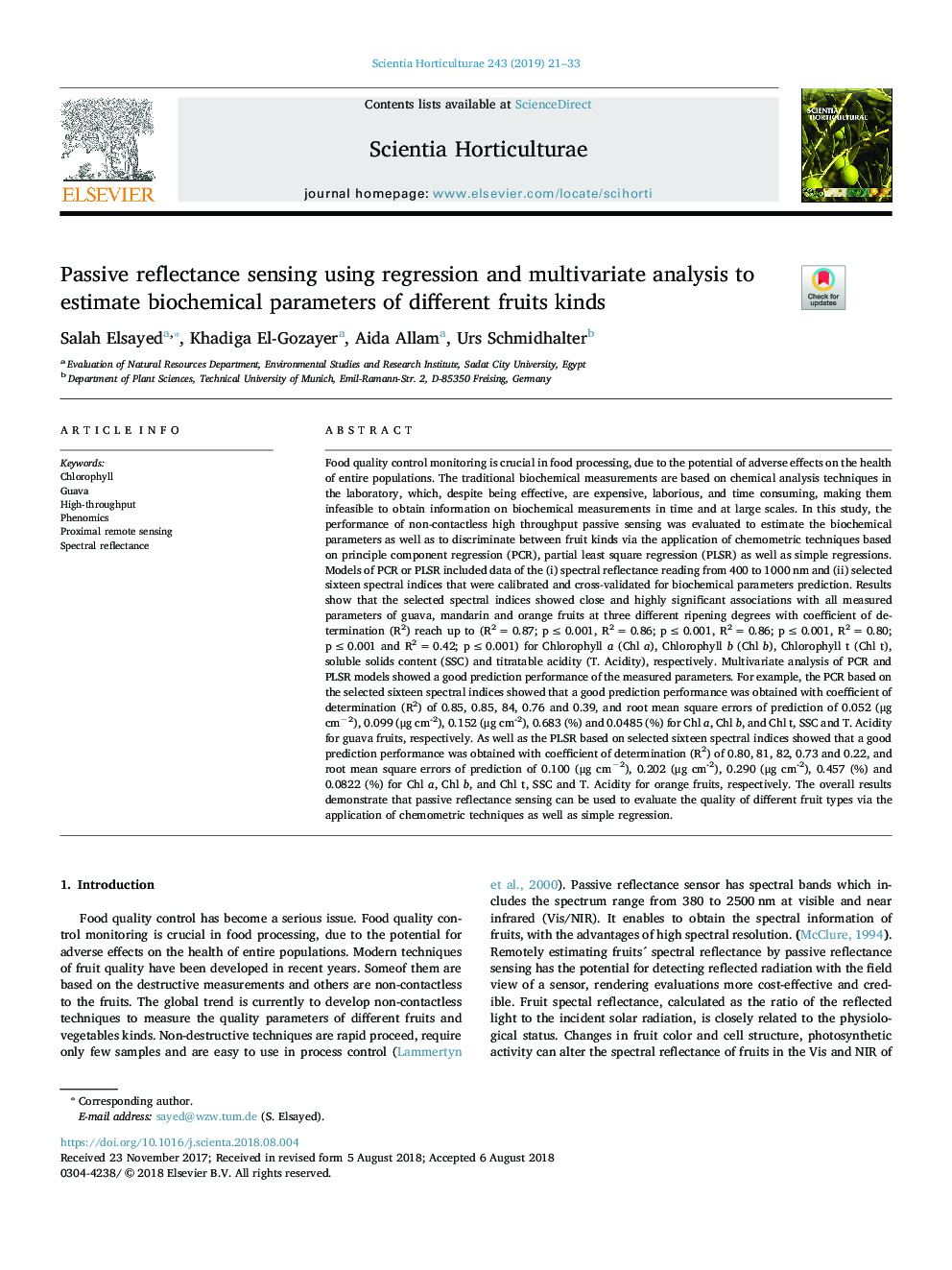| کد مقاله | کد نشریه | سال انتشار | مقاله انگلیسی | نسخه تمام متن |
|---|---|---|---|---|
| 8892271 | 1628755 | 2019 | 13 صفحه PDF | دانلود رایگان |
عنوان انگلیسی مقاله ISI
Passive reflectance sensing using regression and multivariate analysis to estimate biochemical parameters of different fruits kinds
ترجمه فارسی عنوان
سنجش بازتاب منفعل با استفاده از رگرسیون و تحلیل چند متغیره برای تخمین پارامترهای بیوشیمیایی انواع مختلف میوه ها
دانلود مقاله + سفارش ترجمه
دانلود مقاله ISI انگلیسی
رایگان برای ایرانیان
کلمات کلیدی
کلروفیل، گواوا، با توان بالا پنیومیکس، سنجش از دور پروکسیمال، منعکس کننده طیفی،
موضوعات مرتبط
علوم زیستی و بیوفناوری
علوم کشاورزی و بیولوژیک
دانش باغداری
چکیده انگلیسی
Food quality control monitoring is crucial in food processing, due to the potential of adverse effects on the health of entire populations. The traditional biochemical measurements are based on chemical analysis techniques in the laboratory, which, despite being effective, are expensive, laborious, and time consuming, making them infeasible to obtain information on biochemical measurements in time and at large scales. In this study, the performance of non-contactless high throughput passive sensing was evaluated to estimate the biochemical parameters as well as to discriminate between fruit kinds via the application of chemometric techniques based on principle component regression (PCR), partial least square regression (PLSR) as well as simple regressions. Models of PCR or PLSR included data of the (i) spectral reflectance reading from 400 to 1000ânm and (ii) selected sixteen spectral indices that were calibrated and cross-validated for biochemical parameters prediction. Results show that the selected spectral indices showed close and highly significant associations with all measured parameters of guava, mandarin and orange fruits at three different ripening degrees with coefficient of determination (R2) reach up to (R2â=â0.87; pââ¤â0.001, R2â=â0.86; pââ¤â0.001, R2â=â0.86; pââ¤â0.001, R2â=â0.80; pââ¤â0.001 and R2â=â0.42; pââ¤â0.001) for Chlorophyll a (Chl a), Chlorophyll b (Chl b), Chlorophyll t (Chl t), soluble solids content (SSC) and titratable acidity (T. Acidity), respectively. Multivariate analysis of PCR and PLSR models showed a good prediction performance of the measured parameters. For example, the PCR based on the selected sixteen spectral indices showed that a good prediction performance was obtained with coefficient of determination (R2) of 0.85, 0.85, 84, 0.76 and 0.39, and root mean square errors of prediction of 0.052 (μg cmâ2), 0.099 (μg cm-2), 0.152 (μg cm-2), 0.683 (%) and 0.0485 (%) for Chl a, Chl b, and Chl t, SSC and T. Acidity for guava fruits, respectively. As well as the PLSR based on selected sixteen spectral indices showed that a good prediction performance was obtained with coefficient of determination (R2) of 0.80, 81, 82, 0.73 and 0.22, and root mean square errors of prediction of 0.100 (μg cmâ2), 0.202 (μg cm-2), 0.290 (μg cm-2), 0.457 (%) and 0.0822 (%) for Chl a, Chl b, and Chl t, SSC and T. Acidity for orange fruits, respectively. The overall results demonstrate that passive reflectance sensing can be used to evaluate the quality of different fruit types via the application of chemometric techniques as well as simple regression.
ناشر
Database: Elsevier - ScienceDirect (ساینس دایرکت)
Journal: Scientia Horticulturae - Volume 243, 3 January 2019, Pages 21-33
Journal: Scientia Horticulturae - Volume 243, 3 January 2019, Pages 21-33
نویسندگان
Salah Elsayed, Khadiga El-Gozayer, Aida Allam, Urs Schmidhalter,
